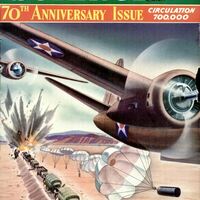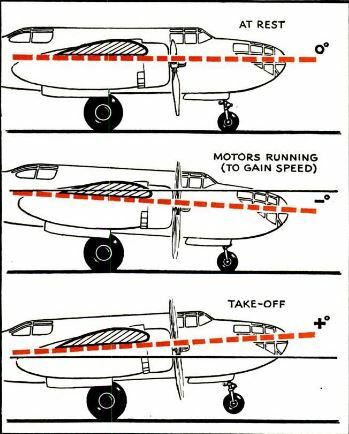-
Title (Dublin Core)
-
A-20 Bombers Squadron Overview
-
Article Title and/or Image Caption (Dublin Core)
-
Title: Speedy, Hard-Hitting, Bombers Form The Porcupine Squadron
-
extracted text (Extract Text)
-
YOU may talk all you want about your
heavy bomber, which comes in from
almost incredible distances and un-
packs its punches from invisible altitudes.
Nobody but its own crew is ever going to
love it. Nobody ever loves the fighter with
a bicycle, who dances around the corners
of the ring and lets loose his blows by re-
mote control.
This story is about a lightweight. It
hasn't been ballyhooed nearly as much as
the big boy, but it's the fastest, toughest,
bloodthirstiest infighter on wings.
With its shoulders hunched forward in a
Jack Dempsey crouch, it sails right in and
mixes it up on the enemy’s own ground,
with kidney jabs and rabbit punches. When
the American soldier comes personally to
grips with the enemy, this plane will be
right in there with him, bombing from 75
feet above ground, biting in the clinches.
The American soldier is going to love it,
as an intimate comrade in arms. The British
love it already, for the enemies it has
slaughtered.
In its already long record of homicidal
wickedness, this ship has four aliases.
Americans know it as the DB-7 and the
A-20A. The British call it the Boston and
the Havoc. It has as many specialties as
it has names, but whatever may be the job,
it always has the same fingerprints and
sharklike killer's mug. It is the Douglas
light bomber.
Designed as a bomber, weighing 91% tons
loaded, this twin-engined plane attained its
first great usefulness as a fighter, and a
night fighter at that. It first reached Eng-
land at a time when the British were con-
cerned, not with the ground-straf-
ing of troops, but with the inter- |
ception of the night bombers which
were destroying London. The
Night Interceptor Command took ;
the ship, blacked out its goldfish- |
bowl nose where the bombardier
sat, and filled the space with the |
greatest arsenal of cannon and i
machine guns ever put into a fight-
ing plane. They shrouded the |
ship's exhausts with long tail pipes
to hide the spitting flames and fit-
ted it with secret devices for scent- |
ing enemies at night. They cut a
ton off its loaded weight. They |
called this modification the Havoc. |
Soon it was knocking down night
bombers as they came in over the |
Channel, getting the reputation for |
destroying more of them than any
other interceptor. Then a still |
more aggressive job was devised
for it, described as “night intru- |
sion.” The Havoc slips over to the
Continent, using its 1,200-mile |
range, and lurks near a Nazi air-
drome like a weasel around a hen |
coop, picking off the bombers as |
they start out for England or come
home to roost.
To the American builders, this
metamorphosis of the DB-7 was a |
surprise and a delight. The manu- :
facturers put it into mass produc- |
tion, hopped up its power. It was
one of the very first ships to get double-
row engines. The British aeronautical press,
never inclined to overpraise American
planes, was permitted to report that Havoc
III, the latest version, had a top speed of
380 miles an hour. This would make this
relatively heavy ship faster than the Hur-
ricane, right in the Spitfire class.
Meanwhile the American, light-bomber,
version of the ship was christened the Bos-
ton by the R.A.F. and was found useful not
only for attack work by daylight but also
for the highly important jobs of observation
and reconnaissance,
Naturally the success of their flying pro-
tégé in the night life of the Continent tend-
ed to cramp the style of the light-bom-
bardment men in the U. S. Air Forces. They
couldn't get as many ships as they wanted,
but they had enough of the A-20 to try it
out thoroughly in their own tactics, a tech-
nique of attack which they had been de-
veloping for the last 20 years. This is a
type of low-down assault so utterly differ-
ent from the uses of the Havoc that it is
amazing for one ship to be useful for both
purposes. But the A-20 turned out to be
an ideal ship for contour flying, which the
pilots themselves call grass-cutting or
skipping through the dew.
Let's take a look at the A-20. It is a
shoulder-wing monoplane, with its two ra-
dial engines in two big underslung nacelles,
which taper back far beyond the trailing
edge of the wings. The big wheels of the
tricycle landing gear retract into these
nacelles. The narrow fuselage projects for-
ward into a nose almost as long as the tail
which leads back to an unusually high fin.
The pilot's single cockpit is forward of the
propellers and the bombardier’s transpar-
ent compartment occupies the nose. The
gunner (or gunner and observer) can work
both from a rear cockpit and from an open-
ing in the plane's belly. The ship has a
span of 61 feet 4 inches and is 47 feet 7
inches long. Loaded it weighs 19,500
pounds.
Even sitting on the ground, the plane has
a sporty, aggressive look, as though its
shoulders were hunched forward ready for
a fight. Studying this, vou realize that its
wings are tilted, not up, but downward.
They have what the aeronautical engineers
call a negative angle of attack. Speeding
down the runway on the take-off, the plane
has no immediate impulse to fly, but rather
presses its nose down, taking up all the
slack in the shock absorber on the forward
wheel of the landing gear. To start it flying,
the pilot has to pull back on the stick, push-
ing the tail down. To cut down wind resist-
ance and increase speed, this ship takes ad-
vantage of a remarkable fact of aerody-
namics: that a wing with unsymmetrical
camber (bulging on top and flat on the
bottom) can lift without being turned up
into the wind, can lift even when it is
cocked down. This peculiarity makes neces-
sary a very high landing speed. The A-20
is a hot ship.
But the exciting thing about this ship is
the way it is used, by the American light
bombers as well as by the British night
fighters. The A in its name stands for “at-
tack,” and the flyers who use it were known
officially until two years ago as attack
squadrons. Their tactics, on which these
squadrons have been working for the last
20 years, are to fly in upon an objective at
such low altitude that they practically skim
the treetops. By using parachute bombs
which give them an instant for escape, they
can blast troops from an altitude of only
75 feet and be safely out of the way before
the explosions. Otherwise, they would be
felled by their own bombs.
The A-20A flyers of the 3rd Bombardment
Group (Light) pride themselves that, fol-
lowing the contours of the land at 75 feet
altitude, . they can go to an objective 300
miles away and bomb it within a half min-
ute of a specified time. Plenty of flyers in
this outfit have nicked the tops out of pine
trees in the course of their training. During
the Louisiana maneuvers an A-20 pilot
sheared his plane through a cluster of five
high-tension wires, without damage to any-
thing but the power line.
The surprise and terror of an approach
by a flight of these planes, flying more than
300 miles an hour so close that you can
almost touch them, is something which
must be seen and heard to be appreciated.
When I first saw them, a flight of eight
A-20's, followed by Navy Grummans and
P-39 pursuit ships, came in suddenly and
low over an air field in North Carolina.
There were 12 press photographers there,
but so fast and furiously did those planes
arrive and depart that not a photographer
got a shot at them. It would have been
even more difficult to catch them with a ma-
chine gun.
Imagine a road through the jungle,
streaming with Japanese troops. Suddenly
there is a roar of approaching planes, but
before the direction of approach can be
identified, the planes appear over the tree-
tops only a few hundred yards away, travel-
ing 160 yards a second. There are three of
them, one for the center, one for each side
of the road. Before a machine gun can be
aimed, they are over and past, each drop-
ping a bomb every ten yards for 1,000
yards. By the time this article gets into
print, it may not be necessary to imagine
this scene of destruction. It may very well
have happened.
Recently I flew on a mission with one of
these squadrons. Out of consideration for
local residents they were flying at an alti-
tude of 500 feet or above, but over a stretch
of uninhabited country they came down
close over the treetops and showed me what
hedge-hopping is really like. Sitting up in
the transparent nose of the lead plane,
traveling better than 300 miles an hour,
over treetops which often were no more
than 20 feet below, following the hills up
and down like a skier—it was an experience
which can only be stated, not adequately
described.
Flying as a squadron this way, we were
almost proof against attack. Ground ob-
servers’ more than a few hundred yards
away could not see us. Often we were down
in a ravine with ridges of land rising on
cither side. Pursuit planes could not get
at us. The A-20 has a critical altitude of
1,000 feet above sea level; that is, its en-
gines perform best when right down by the
ground. Most pursuit planes are built to fly
above the clouds, and they will burn their
engines out if they fly at wide-open throttle
close to the ground. To get at us, at our
speed, fighter ships would have to dive.
And when a fighter ship pulls out of a
power dive, it mushes or squashes through
the air for a long distance before its wings
finally support it. A plane diving at us
would have a very good chance of crashing
into the ground. Assuming that fighter
ships did get down close to our level, they
could not get under us. And if they
came in over us they would confront a
close-flying phalanx whose back was a
bristling nest of machine guns, as dan-
gerous to approach as a porcupine.
The A-20 can also be used for level
bombing at higher altitudes, and even
that does not exhaust its usefulness.
It's a lot of plane in one package.
A regular little death-dealing sweet-
| heart!
-
Contributor (Dublin Core)
-
Hickman Powell (Article Writer)
-
Language (Dublin Core)
-
eng
-
Date Issued (Dublin Core)
-
1942-05
-
pages (Bibliographic Ontology)
-
82-88
-
Rights (Dublin Core)
-
Public Domain (Google Digitized)
-
References (Dublin Core)
-
DB-7
-
Archived by (Dublin Core)
-
Roberto Meneghetti
-
Marco Bortolami (editor)
 Popular Science Monthly, v. 140, n. 5, 1942
Popular Science Monthly, v. 140, n. 5, 1942




